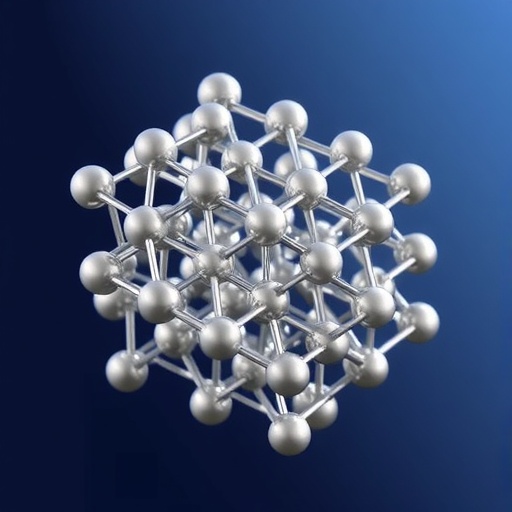Alkaline water electrolyzers, integral to the generation of sustainable hydrogen, have long grappled with intrinsic challenges. The sluggish kinetics of hydrogen evolution reactions (HER) on cathodes, compounded by the instability and agglomeration of platinum nanoparticles, have constituted critical bottlenecks. Additionally, the economic burden, primarily driven by precious metal usage and insufficient durability, has impeded scale-up efforts. Addressing these issues, the new Pt/Mo₂N-NrGO catalyst showcases an exceptional synergy between its composite components, stemming from strategically engineered atomic interfaces primarily characterized by Pt–N–Mo bonding.
At the heart of this innovation lies the meticulous design of the heterostructure facilitated by Anderson-type polyoxometalates as precursors. These molecular clusters undergo nitridation at elevated temperatures, yielding finely dispersed Pt/Mo₂N nanoclusters approximately 2 nanometers in size. This nanoscale precision enables an intimate coupling between platinum and molybdenum nitride domains, fostering strong electronic interactions. Notably, this interfacial coupling manifests in charge transfer dynamics where platinum donates electrons to Mo₂N, resulting in a downshift of platinum’s d-band center. This modulation fine-tunes the hydrogen adsorption free energy, effectively optimizing the HER active sites toward a thermoneutral binding, which is a critical parameter for enhanced catalytic activity.
Operando spectroscopic techniques lend compelling evidence to the bifunctional catalytic mechanism inherent in this heterostructure. In situ Raman spectroscopy detected simultaneous signatures of Pt–H and Mo–OH vibrational modes under electrochemical operation, confirming the concurrent stabilization of hydrogen and hydroxyl intermediates. This dual-site activity enables a Volmer-Tafel pathway typically associated with acidic platinum catalysts but realized here within an alkaline environment, breaking conventional paradigms of HER kinetics. Complementary density functional theory (DFT) calculations corroborate this mechanism, revealing a significant reduction in the Volmer reaction energy barrier from 0.93 eV on pristine Pt(111) surfaces to a mere 0.36 eV on the Pt/Mo₂N interface.
Scaling laboratory successes to practical applications, this catalyst was integrated into an anion-exchange membrane water electrolyzer (AEMWE) system, paired with nickel-iron layered double hydroxide (NiFe LDH) as the anode. Impressively, the system achieved industrially relevant current densities of 1 and 2 A cm⁻² at operational voltages of only 1.66 V and 1.84 V respectively, operating at 80 °C. These values not only outperform benchmarks set by commercial Pt/C systems but also maintain exceptional energy efficiencies, peaking at 95% at moderate current densities, and exceeding 88% even at 1 A cm⁻², highlighting its potential to minimize operational costs in electrolyzer deployment.
The techno-economic implications of this innovation are profound. By integrating the Pt/Mo₂N-NrGO heterostructure into a 1 MW electrolyzer plant model, researchers demonstrated a levelized cost of hydrogen (LCOH) of $2.02 per kilogram, aligning with and even slightly surpassing the US Department of Energy’s stringent cost targets for green hydrogen. This achievement was made possible by drastically reducing platinum loading — made feasible by the nanoscale interface design — and optimizing operating current densities to balance capital expenditures (CAPEX) and operational expenditures (OPEX). Specifically, CAPEX trends downward significantly when scaling from 100 to 2000 mA cm⁻² due to improved mass transport and reaction kinetics, whilst OPEX remains predominantly influenced by electricity costs. An operational sweet spot was identified at approximately 560 mA cm⁻², maximizing cost-efficiency.
Beyond immediate performance metrics, the research team outlined a pragmatic roadmap toward large-scale industrial adoption. Their roll-to-roll spray-coating technique has already been validated on cells measuring 12 by 2 centimeters, demonstrating promising prospects for scalable manufacturing. Leveraging earth-abundant precursors such as molybdenum and nitrogen-rich urea further enhances sustainability credentials by reducing the reliance on scarce noble metals by up to 80% compared to state-of-the-art Pt/C catalysts. The envisaged future extends to adapting this cluster heterostructure strategy for seawater electrolysis and nitrate reduction, converting otherwise waste and low-grade feedstocks into valuable hydrogen and chemical intermediates.
The underpinning scientific insights garnered from this study usher in a new paradigm in catalyst design for alkaline water electrolysis. By harnessing the atomic-scale “nano-scissors” effect—where a synergistic interaction between Pt sites that stabilize adsorbed hydrogen and Mo sites that anchor hydroxyl groups facilitates rapid water splitting—the researchers have not only addressed kinetic limitations but also delivered unprecedented catalyst longevity. This dual-site catalytic mechanism may well become the cornerstone for next-generation electrolyzers capable of meeting growing global demands for sustainable hydrogen production.
A critical facet enabling this innovation was the utilization of advanced characterization methods deftly combined with computational modeling. Extended X-ray absorption fine structure (EXAFS) spectroscopy pinpointed Pt–N–Mo bonding distances at approximately 1.56 Å, validating the formation of tightly coupled heterostructures. Concurrently, DFT provided atomistic-level insights into electron density redistribution and reaction energy profiles, substantiating the experimentally observed performance enhancements. This integrated approach exemplifies how modern materials science can accelerate breakthroughs from synthesis to mechanistic understanding to technological deployment.
Conclusively, this research propels the field of water electrolysis forward, marrying fundamental chemistry with practical engineering to facilitate the global hydrogen economy transition. The strategic design principles elucidated by the Pt/Mo₂N-NrGO heterostructure offer a template upon which future catalysts might be engineered to unlock even greater efficiencies and cost reductions. As this technology migrates from benchtop experiments toward megawatt-scale electrolyzer stacks, it holds the transformative potential to shift green hydrogen from a niche solution to a ubiquitous clean energy vector, ultimately helping mitigate climate change and fuel a sustainable future.
Subject of Research: Experimental study on advanced catalysts for alkaline water electrolyzers.
Article Title: A Strongly Coupled Cluster Heterostructure with Pt–N-Mo Bonding for Durable and Efficient H2 Evolution in Anion-Exchange Membrane Water Electrolyzers
News Publication Date: 13-Jun-2025
Web References: http://dx.doi.org/10.1007/s40820-025-01798-x
Image Credits: Wenbo Zhou, Yichao Huang, Hanqing Cai, Tao Wang, Haitao Li, Chao Zhang, Lianming Zhao, Lulu Chen, Meihong Liao, Zhiqing Tang, Kai Chen, Jing Gu, Wenpei Gao, Zhuangjun Fan, Zhenhai Wen.
Keywords: Evolution
Tags: anion-exchange membrane electrolyzerscollaborative research in energy technologycost-effective hydrogen productiondurable hydrogen production technologyefficient alkaline water electrolysisgreen hydrogen advancementsheterostructure catalyst designhydrogen evolution reaction kineticsnitrogen-doped graphene oxideplatinum nanoparticle stabilityPt Mo2N nanocluster catalystsustainable hydrogen generation





